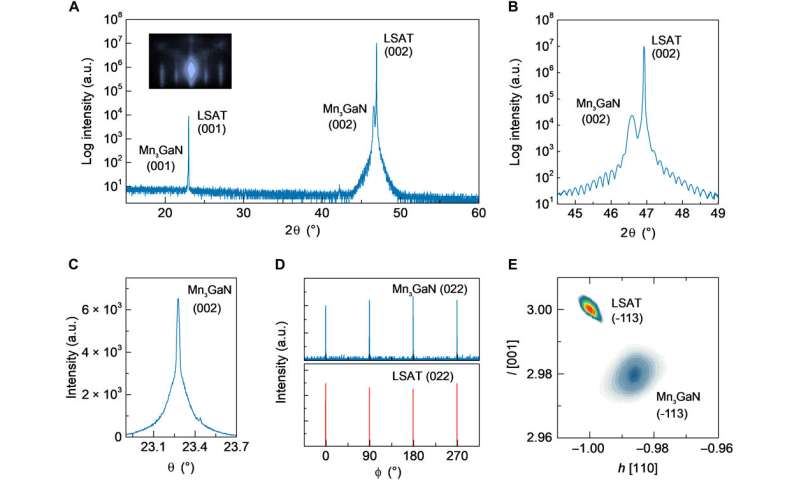#Epitaxial antiperovskite/perovskite heterostructures for materials design
“#Epitaxial antiperovskite/perovskite heterostructures for materials design”
![HAADF-STEM images of the Mn3GaN/LSAT interface and corresponding recorded EDS. (A) and (B) [100]-projected HAADF-STEM images of the Mn3GaN/LSAT interface and (below each image) corresponding recorded EDS data along the atomic rows represented by yellow arrows in the HAADF-STEM image. EDS line profiles across the interface show a dominant Mn signal at the interface. Overlaid on the HAADF-STEM images is the proposed atomic configuration at the interface based on EELS and EDS analyses. Credit: <i>Science Advances</i>, doi: 10.1126/sciadv.aba4017″></img><figcaption>
HAADF-STEM images of the Mn3GaN/LSAT interface and corresponding recorded EDS. (A) and (B) [100]-projected HAADF-STEM images of the Mn3GaN/LSAT interface and (below each image) corresponding recorded EDS data along the atomic rows represented by yellow arrows in the HAADF-STEM image. EDS line profiles across the interface show a dominant Mn signal at the interface. Overlaid on the HAADF-STEM images is the proposed atomic configuration at the interface based on EELS and EDS analyses. Credit: <i>Science Advances</i>, doi: 10.1126/sciadv.aba4017<br />
</figcaption></figure>
</div>
</div>
<p><b>Perovskite and antiperovskite crystals </b><br />
Perovskite crystals are usually oxides with positively and negatively charged ions with promising optical, magnetic and electrical properties. In antiperovskites the placement of the positively and negatively charged ions are flipped to create another class of materials with different properties to perovskites. Antiperovskite materials are intermetallic materials with perovskite crystal structure and much like their oxide perovskite counterparts they show a variety of tunable physical properties including superconductivity, ferromagnetism, magnetoresistance and topological electronic behavior. Among such anti-perovskite materials, transition metal-based nitride compounds, denoted M<sub>3</sub>XN, where M equals transition metal and X equals metallic or semiconducting elements, are particularly interesting, with high sensitivity to magnetic fields, temperature or pressure. Such materials sensitivities result from strong spin-lattice coupling characteristics of M<sub>3</sub>XN compounds, which can be tuned or manipulated through strain engineering. Additionally, scientists have used the physical properties of ABO<sub>3</sub> oxide perovskites as external triggers to tune the functionality of antiperovskite materials. The ABO<sub>3</sub> compounds are unrivalled material systems to interface with M<sub>3</sub>XN nitride antiperovskites due to their analogous structures, to promote epitaxial growth (the assembly of dissimilar materials into a single film). To explore epitaxy at the atomic level, Quintela et al. investigated the interfacial structure and chemistry between nitride antiperovskite and oxide perovskite materials.</p>
<p> <b>Developing and characterising the nitride antiperovskite/oxide perovskite interface</b><br />
In this work Quintela et al. fabricated a high-quality Mn<sub>3</sub>GaN film on (La<sub>0.3</sub>Sr<sub>0.7</sub>)(A<sub>l0.65</sub>Ta<sub>0.35</sub>)O<sub>3</sub> (abbreviated LSAT) and strontium titanate single-crystal substrates as paradigms of M<sub>3</sub>XN/ABO<sub>3 </sub>interfaces. Using X-ray diffraction (XRD), they structurally characterized the 60-nm thick Mn<sub>3</sub>GaN film grown on the LSAT substrate and monitored the epitaxial growth and single-phase structure of the films using reflection high-energy electron diffraction (RHEED). The results showed the high crystalline quality of the film and the pristine interface. </p>
<div>
<div data-src= Epitaxial antiperovskite/perovskite heterostructures for materials design](https://scx1.b-cdn.net/csz/news/800/2020/1-epitaxialant.jpg)

To understand the structure and chemical composition of the Mn3GaN/LSAT interface, Quintela et al. combined atomic-resolution scanning transmission electron microscopy (STEM) with electron energy-loss spectroscopy (EELS) and energy-dispersive X-ray spectroscopy (EDS). The first interfacial Mn3GaN monolayer showed a pattern of alternating bright and dark spots to indicate compositional or structural reconfiguration at the interface. Using simulations and structural chemical analyses, the team showed transitions from the LSAT substrate to the Mn3GaN film mediated through a sharp interfacial monolayer. To determine the atomic structure of this interfacial monolayer, Quintela et al. performed additional STEM and EDS studies and showed the ordering of atoms in a two-dimensional (2-D) periodic structure with rotational symmetry.
First-principles calculations
The team performed first-principles calculations to study the stability of the interfacial model derived from atomic resolution experiments. Using simulations, they calculated the formation energies to test for stability and confirmed the interfacial model to be energetically stable. Additional work, however, showed apparent discrepancies between the experimental and theoretical studies, which the scientists credited to the onset of Mn3GaN growth in the presence of an energy barrier, where the discrepancy prevented the system from relaxing from the local to the global energy minimum. Quintela et al. further explored this hypothesis in their work. The combined experimental and theoretical studies showed how the interfacial monolayer worked as a structural bridge between the perovskite substrate and antiperovskite film to establish heteroepitaxy between the nonisostructural (dissimilar crystal structure) materials with different chemical composition and binding.
More information:
Camilo X. Quintela et al. Epitaxial antiperovskite/perovskite heterostructures for materials design, Science Advances (2020). DOI: 10.1126/sciadv.aba4017
J. Mannhart et al. Oxide Interfaces—An Opportunity for Electronics, Science (2010). DOI: 10.1126/science.1181862
A. H. MacDonald et al. Antiferromagnetic metal spintronics, Philosophical Transactions of the Royal Society A: Mathematical, Physical and Engineering Sciences (2011). DOI: 10.1098/rsta.2011.0014
© 2020 Science X Network
Epitaxial antiperovskite/perovskite heterostructures for materials design (2020, July 30)
retrieved 30 July 2020
from https://phys.org/news/2020-07-epitaxial-antiperovskiteperovskite-heterostructures-materials.html
This document is subject to copyright. Apart from any fair dealing for the purpose of private study or research, no
part may be reproduced without the written permission. The content is provided for information purposes only.
If you want to read more Like this articles, you can visit our Science category.
if you want to watch Movies or Tv Shows go to Dizi.BuradaBiliyorum.Com for forums sites go to Forum.BuradaBiliyorum.Com



